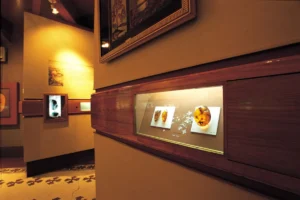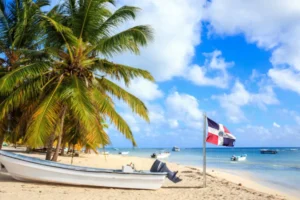Craving an adventure where turquoise waters meet jungle peaks and every trail leads to a hidden paradise? Then, you’re in the right place. Moreover, hiking in the Dominican Republic is more than a walk in the nature. It’s an immersive journey through waterfalls, cloud forests, and coastal cliffs that will challenge your legs and awaken your soul.
If so, you’re excited to learn about this adventure, then continue reading.
Hiking in the Dominican Republic: options for every level
Whether you’re a seasoned trekker or a nature-loving beginner, the island offers hikes for every level and interest. First, from the towering Pico Duarte to family-friendly eco-trails near the coast, your next unforgettable trail is just a plane ride away.
Next, are the options:
Pico Duarte – The summit of the Caribbean
At 3,087 meters, Pico Duarte is the highest mountain in the Caribbean. Therefore, the hike is a rite of passage for adventurers seeking bragging rights and panoramic views above the clouds.
Typically, the journey usually begins in Jarabacoa and takes you through pine forests, river crossings, and rustic mountain cabins. Consequently, it’s a multi-day trip that offers hikers breathtaking natural scenery.
And what are its characteristics??
- Difficulty: Hard.
- Duration: 2–3 days.
- Region: Cordillera Central.
Salto El Limón, a short trek to a stunning waterfall
If you are looking for one of the most famous waterfalls in the Dominican Republic, Salto El Limón is a must. This 40-meter cascade can be reached via a scenic hike through coconut groves and tropical forest. Along the way, you will spot birds, butterflies, and local farms.
- Difficulty: Easy to moderate.
- Duration: 1–2 hours roundtrip.
- Region: Samaná Peninsula.
Ébano Verde Scientific Reserve: for birdwatchers and botanists
Ébano Verde is protected cloud forest. In addition, it is a haven for biodiversity. Well-marked trails wind through dense vegetation, and interpretive signs highlight endemic species. So, it is an ideal destination for families and nature lovers interested in flora and fauna. Next, are the details:
- Difficulty: Easy to moderate.
- Duration: 1–3 hours.
- Region: Constanza.
Los Haitises National Park: jungle trails and hidden caves
Accessible by boat and foot, Los Haitises offers a unique hiking experience. Furthermore, limestone formations, mangrove forests, and ancient Taino caves await exploration. Also, the trails here combine adventure with history and are best experienced with a local guide.
- Difficulty: Moderate.
- Duration: Half-day.
- Region: Northeast coast.
Anamuya Mountains: close to Punta Cana, far from the crowds
Located near the Punta Cana resorts; this range offers an accessible escape into nature. The Anamuya trails are perfect for a morning hike with great views and occasional wildlife sightings. Some tours include cultural stops at cacao or coffee plantations.
- Difficulty: Moderate.
- Duration: 2–3 hours.
- Region: Eastern region.
What makes hiking in the Dominican Republic unique?
There are many reasons why hiking in the Dominican Republic is something you cannot miss when visiting this beautiful country:
- First, the diverse ecosystems: from arid scrublands to cloud forests, the Dominican Republic boasts incredible ecological variety.
- Second, the biodiversity: more than 6,000 plant species make every hike a learning experience (Caribbean Biodiversity Fund, 2025).
- Third, the cultural immersion: many trails pass through local villages, offering authentic glimpses of rural Dominican life.
- And the proximity to luxury: after a rugged hike, return to a private villa with a pool, massage service, or a chef-prepared dinner.
Hiking in the Dominican Republic means you don’t have to choose between adventure and comfort. In fact, with Homebelike, you can have both!
Hiking in the Dominican Republic: culture, spirit, and wellness
While most people picture hiking in the Dominican Republicas scenic climbs and lush forests, in reality, hiking here can be much more than a physical journey. Indeed, hidden in its mountain paths and coastal trails are stories, rituals, traditions, and moments of healing that connect travelers with the island’s spiritual energy, ancestral wisdom, and cultural heartbeat.
For those willing to go beyond the Instagram moments, hiking in this Caribbean paradise can be a gateway to:
- Emotional reset.
- Also, cultural understanding.
- And, personal transformation.
Hiking in the Dominican Republic as a cultural lens: stories in every step
Every trail in the Dominican Republic carries echoes of the past. So, whether you’re walking through cacao plantations, crossing rural mountain villages, or exploring cave systems with Taino petroglyphs, you’re stepping into centuries of living history.
Taino footprints and ancestral caves
Before the arrival of the Spanish, the island was home to the Taino people, an Indigenous culture with deep ties to nature and the spiritual world. So, hiking through Los Haitises National Park or El Pomier Cave System reveals ancient rock art, sacred spaces, and myths that still shape local belief systems today.
Moreover, for families or solo travelers, guided hikes that focus on Taino cosmology are a unique way to learn about native astronomy, medicine, and creation myths, all while immersed in jungle landscapes.
Coffee and cacao routes with local farmers
On the other hand, in the highlands of Jarabacoa and Constanza, trails often pass by family-run coffee and cacao farms. Some routes are part of agro-tourism experiences where hikers can stop, meet the farmers, and learn how these crops are grown, harvested, and processed. For kids and adults alike, this is a rare chance to walk through the full life cycle of a chocolate bar or coffee cup, from tree to taste.
Local farmers are often open to storytelling, sharing folktales that passed down for generations. These are moments you can’t find in guidebooks or Google Maps.
Spiritual hiking in the Dominican Republic: the trail as therapy
For travelers seeking emotional clarity or spiritual connection, hiking in the Dominican Republic offers an environment where stillness and reflection come naturally. Surrounded by vibrant greenery, distant birdsong, and wide-open skies, hikers often report feeling grounded, peaceful, and reset.
Also, hiking is a chance to unplug and reconnect; especially for families traveling with different generations. The Dominican Republic offers the ideal setting for this, with trails that range from rugged treks to stroller-friendly eco-paths.
Forest bathing with a Caribbean twist
“Forest bathing,” or shinrin-yoku, is a wellness practice that originated in Japan. It involves walking slowly and mindfully through a forest, tuning into your senses. In the Dominican Republic, many wellness-focused guides have adapted this to local landscapes, offering mindful walks through pine forests, cloud forests, and tropical jungles.
Moreover, these hikes often include moments of silence, breathwork, or journaling prompts. Travelers describe them as powerful resets for the nervous system and a way to reconnect with inner clarity.
Grandparents hiking in the Dominican Republic: accessibility options
Hiking with older family members? Don’t worry: there are accessible trails with shaded rest areas, gentle gradients, and cultural points of interest that make the experience rewarding for everyone. In fact, some eco-lodges offer mobility-friendly excursions, including transport to scenic vistas and guided walks at a slower pace.
Hidden healing spots along the trails
Beyond the standard hiking map, there are places Dominicans consider energetic or healing points, where nature’s energy is said to be particularly strong. Here are some examples:
- The River Baths of Damajagua. Beyond the adrenaline of sliding down the 27 waterfalls of Damajagua, many locals believe the mineral-rich waters are good for joint pain, skin conditions, and stress relief. Whether or not you buy into science, there’s no denying how therapeutic it feels to float in cool, clear pools surrounded by forest.
- “Altars” in the Mountains. Some trails near La Vega and San José de Ocoa pass by local altars or crosses where villagers leave candles or flowers. These spots are often dedicated to saints or local spiritual guides and serve as reflection points. So, if you’re respectful, these places invite quiet contemplation and a connection to Dominican spirituality.
Trail-to-table experiences: food that completes the hike
The reward at the end of a trail isn’t always a view; sometimes, it’s a meal. Therefore, in many rural areas, hiking is followed by trail‑to‑table cuisine, where locals prepare traditional dishes using ingredients grown along the very path you walked.
For instance, some guides offer half‑day hikes that end with a Dominican‑style cookout on the riverbank: grilled fish, plantains, rice and beans, and fresh coconut water served on banana leaves. It’s a picnic with soul, and it’s one of the tastiest ways to refuel.
Hiking in the Dominican Republic: giving back along the way
Another dimension of hiking here is community involvement. For example, travelers can opt for trails that directly support local development projects or conservation efforts. Here are some ideas:
· Trails that fund reforestation. In places like Barahona and San Juan, guided hikes contribute to local reforestation initiatives. As a result, every participant helps fund tree-planting efforts, and some tours even allow you to plant a sapling with your name on it, a legacy you leave behind on the trail.
· Volunteer hiking programs. Some organizations organize volunteer treks where you hike with purpose, such as cleaning trails, delivering supplies to remote schools, or mapping new paths for the community ecotourism. Thus, these experiences leave a lasting impact, not just on you, but on the communities you visit.
Hiking in the Dominican Republic with heart
Yes, the Dominican Republic has waterfalls, jungle trails, and epic peaks. Nevertheless, it also offers something rarer: a chance to connect deeply with the land, its people, and yourself. Hiking here isn’t just an outdoor activity; it’s a cultural, emotional, and even spiritual journey if you’re open to it.
So, when you plan your next hiking in the Dominican Republic trip, don’t just ask where the trails go. Ask what they offer your heart, your family, your sense of wonder.
Best times of year for hiking in the Dominican Republic
Now let’s talk about the best months to visit this beautiful place. Pay attention and decide:
- December to April: Dry season; ideal weather, clear skies, and safer trails.
- May to November: Green season; lush scenery, fewer tourists, but occasional rain.
Most trails remain accessible year-round but always check local conditions before heading out.
Also, these are some tips for a safer hike:
• First of all, start early: avoid midday heat and catch the best light.
• Additionally, pack water and snacks: many trails have no services.
• Moreover, use proper footwear: trails can be slippery or rocky.
• If possible, hire a guide: especially for longer or remote hikes.
• Finally, respect nature: stay on marked paths and pack out trash.
Want a completely worry-free adventure? Homebelike’s experience specialists can arrange private guides, packed lunches, and more.
Combine hiking in the Dominican Republic with your luxury stay
Why settle for ordinary accommodations after a day of trekking? Instead, Homebelike offers a curated collection of luxury villas where you can relax, unwind, and recharge. Whether you want a villa near Samaná’s lush trails or a mountain retreat in Constanza, your experience specialist will match you with the perfect stay.
Therefore, browse the Reserve Collection to find your next home base.
Discover hiking-inspired experiences with Homebelike
In brief, whether it’s a romantic sunrise hike, a family-friendly waterfall trek, or a group expedition to Pico Duarte, we help create hiking adventures that suit your pace and preferences. Furthermore, your experience specialist can even combine hiking with:
- Farm-to-table meals.
- Cultural immersion tours.
- Stargazing nights.
- Wellness experiences.
So, explore our full experiences collection or browse the latest adventures we’ve curated just for you.
References
- Caribbean Biodiversity Fund. (2025). Dominican Republic. Caribbean Biodiversity Fund.
- JHSP Online. (2023). Os Banhos de Floresta no Japão. Japan House.



